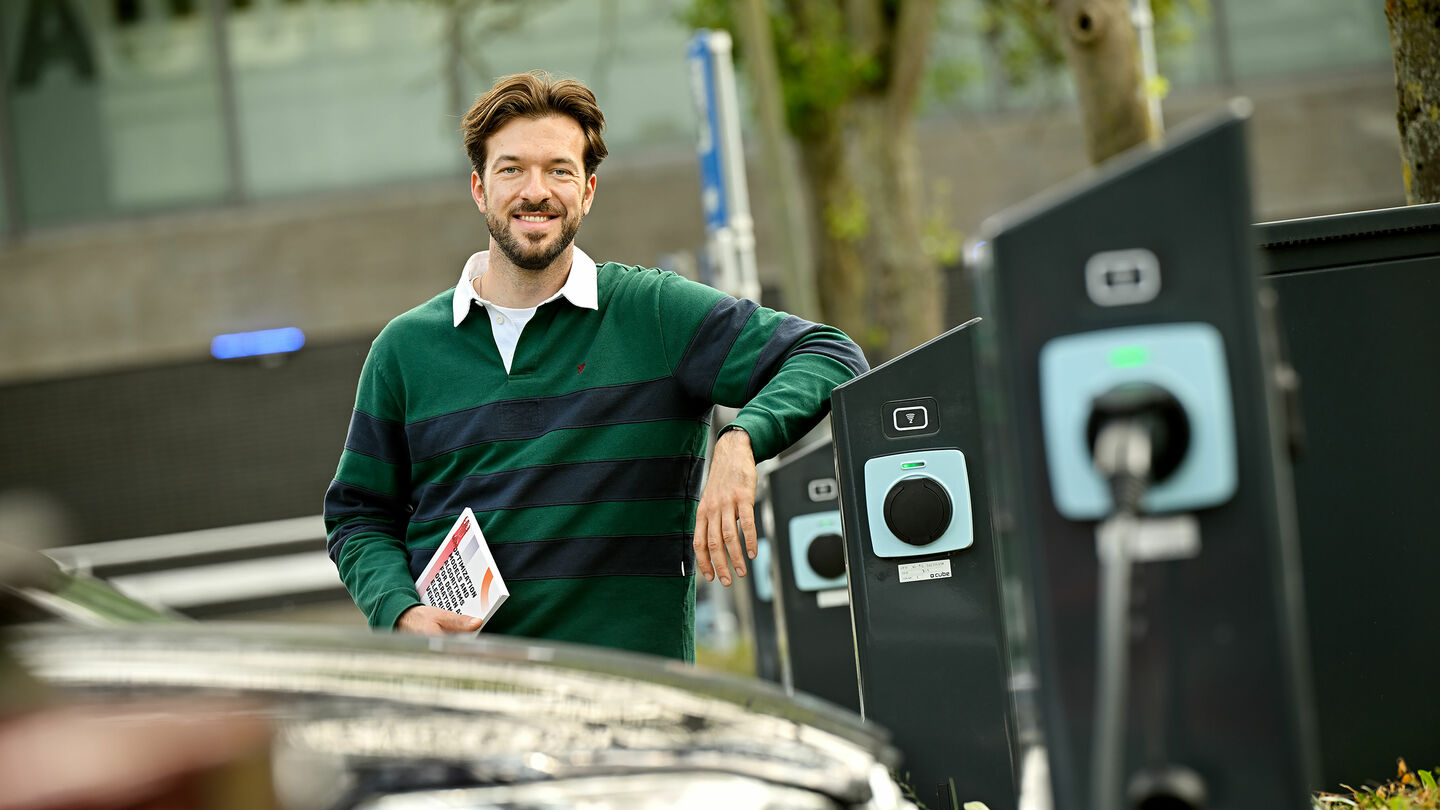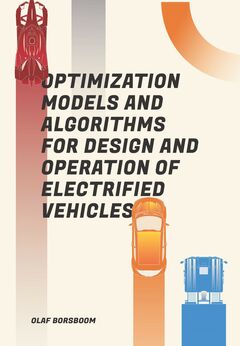
Home Stretch | Making electric cars more efficient
Greater range and lower consumption: this is how we get more out of electric cars
Electric cars have the potential to play a key role in making the transport sector more sustainable, but there is still a lot of room for improvement, says PhD researcher Olaf Borsboom. He studied how the design of these vehicles can be made more efficient in order to reduce energy consumption and increase the range on a single charge. This week, he defended his dissertation at the Department of Mechanical Engineering.
“I find cars fascinating and see them as an essential part of our daily lives. At the same time, there is still plenty of room for improvement,” says Borsboom. Because of the urgent climate problem, it is crucial to make the transport of people and goods more sustainable, as CO₂ emissions are still high. Electric vehicles can play an important role in this, but there are still many challenges to overcome.
“Electric cars don’t emit CO₂ themselves, but the energy used to charge them often still comes from fossil fuels,” says the PhD candidate. “To maximize the environmental benefits, we need to ensure that electric cars are designed as efficiently as possible, consume little energy, and are used in the right way.”
Efficient and powerful
Therefore, the central question in his dissertation was: ‘how can we make the design of electric cars as efficient as possible?’ Borsboom focused specifically on the powertrain – the system that sets the car in motion. In this system, energy is stored in a battery. That energy then has to be released and converted into motion: the electric motor converts the electrical energy into mechanical power, causing the wheels to turn. Between the motor and the wheels is a transmission system – also known as the gearbox – which ensures that the power from the motor matches the speed and desired behavior of the wheels.
“All the components in that chain must work together optimally to make the system as efficient as possible,” says Borsboom. “But at the same time, the car has to remain powerful enough to accelerate swiftly.” So the goal is to achieve a design that consumes less energy – allowing the car to travel further on a single charge – without compromising on performance in terms of acceleration and speed. “This way, we don’t just make electric cars more environmentally friendly, but also more attractive to the user.”
Optimization algorithms
Designing such a complex system for optimal performance is no easy task, Borsboom emphasizes. “A battery is electrochemical, the motor is electromechanical – each component has its own characteristics,” he explains. “You need to carefully coordinate all these components in order to solve the design puzzle.” He used optimization algorithms for this. “You have the computer calculate how the various components perform and how much energy the system consumes.” Based on these calculations, you can estimate how efficient the car is. “You can then simulate all kinds of design choices and see which one yields the best outcome.”
The downside: this requires a lot of computing power, and the simulations take a considerable amount of time. With his dissertation, Borsboom contributed to the improvement of the existing method by building models that are not only accurate but also much faster at performing calculations.
From race cars to trucks
For one of his studies, Borsboom worked with student team InMotion, which designs electric race cars, among other things. “In racing, you want to minimize lap time, but you also have to be careful not to consume too much energy. Otherwise, you might not make it to the finish line or you might have to recharge more often, which also costs valuable time,” he explains. So the key is finding the optimal balance between speed and efficiency.
Borsboom investigated how to calculate that balance and discovered that the “racing problem” is actually the mirror image of the “electric car puzzle”: “There, you want to minimize energy consumption without losing speed. If a truck has to supply several supermarkets from the distribution center, you want to do that in an energy-efficient and fast way. In both cases, you’re looking for a kind of sweet spot.”
A surprising outcome: the method he developed turns out to be applicable to race cars as well as electric passenger cars and trucks – to make them more energy-efficient and increase their range. “People often think that racing is purely for entertainment, but many innovations from the racing world are highly applicable in everyday life,” says the PhD candidate.
The development of more energy-efficient car designs is still in its infancy, he emphasizes. Highly accurate models are needed to design the entire system properly. “In any case, my methods are a good starting point for developing more energy-efficient and optimized vehicle systems.”
Taboo
Borsboom’s PhD journey was marked by drastic events in his personal life. In his third year, his father passed away, while his mother had been dependent on family care for years due to health problems. So finishing his PhD feels like closing a difficult and emotional chapter. “The grieving process doesn’t just stop, but hopefully, I can now turn the page and start a new phase in my life,” he says.
Through his own experience, Borsboom noticed that there is a big taboo surrounding the loss of a loved one. “People often find it uncomfortable and are afraid to ask questions about it, so they’d rather avoid the subject,” he notes. “This is usually well-intentioned – because they don’t want to make you even sadder by talking about it. But that can actually make things feel uncomfortable and isolating. For example, I only found out much later that a colleague in my own department had gone through the same thing. It’s actually quite strange that we don’t talk about it.”
Opening up about grief
Fortunately, Borsboom could always count on the support of his supervisors, and from the university itself. For example, he was given an extra six months to continue his PhD track, giving him space to make all the necessary arrangements during a challenging period, but also to process his loss emotionally. “The project can provide some welcome distraction, but at the same time, it’s important not to bottle up your grief and to make room for the mourning process,” he says. “I’m very grateful for the support and understanding I received. I never felt any pressure to move on and pick up my project again.”
With this experience, Borsboom hopes not only to share his own story, but also to encourage others to open up about grief and loss. “It helps to know that you’re not alone. By talking about it, we can break the taboo and create more understanding – both within the academic community and beyond. I hope to contribute to making this topic easier to talk about – even if it’s just in a small way.”
PhD in the picture
What is that on the cover of your dissertation?
“It’s a race car, a passenger car, and a truck – in order from fastest to slowest, because those are the three applications in my research.”
You’re at a birthday party. How do you explain your research in one sentence?
“I investigate how we can make electric cars and trucks more energy-efficient so they can travel further on a single charge.”
How do you blow off steam outside of your research?
“I like to go to the movies by myself. I have a Cineville card so I can go as often as I want, which makes it very low-threshold. I love stepping into another world for a while. And because I go alone, I can choose what I want to see without having to take anyone else’s preferences into account. Plus, it kind of feels like being incognito, sitting by yourself in a crowded movie theater.”
What tip would you have liked to receive as a beginning PhD researcher?
“Let go of your expectations. It’s good to have a plan, but things almost never go the way you expect. Holding on too tightly to your original expectations can hinder your research process and prevent you from enjoying the end result.”
What is your next chapter?
“I will remain at TU/e until the end of this year, applying my method to the fuel cell of hydrogen-hybrid aircrafts. That way, we’re exploring how to make flying more efficient and reduce emissions. The system is different from that used in cars and trucks, but it’s still all about the powertrain. I’m not exactly sure yet about what I’ll do next, but I don’t expect to stay in academia. Fortunately, I still have some time to think about it.”


Discussion